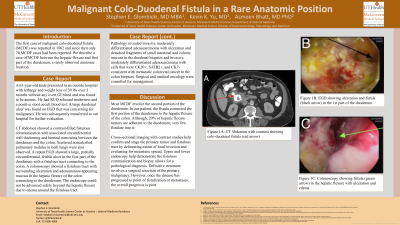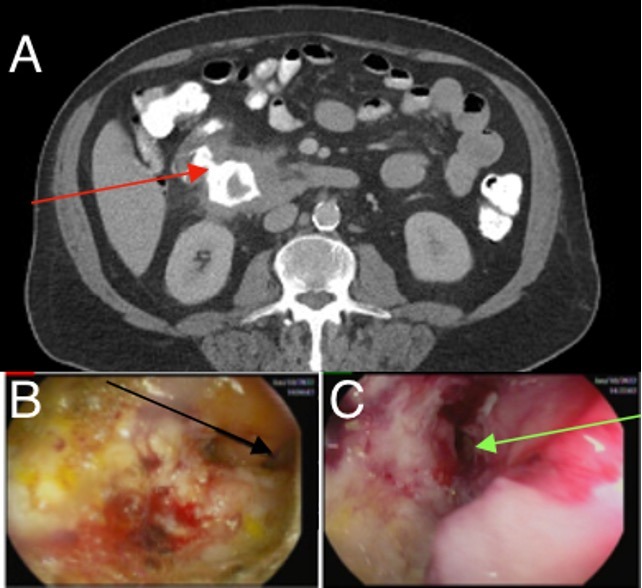Back


Poster Session D - Tuesday Morning
Category: Colon
D0128 - Malignant Colo-Duodenal Fistula in a Rare Anatomic Position
Tuesday, October 25, 2022
10:00 AM – 12:00 PM ET
Location: Crown Ballroom

Has Audio
.jpg)
Stephen E. Glombicki, MD, MBA
University of Texas Health Science Center
Houston, TX
Presenting Author(s)
Stephen E. Glombicki, MD, MBA1, Kevin K. Yu, MD2, Asmeen Bhatt, MD, PhD3
1University of Texas Health Science Center, Houston, TX; 2UT HSC - Houston, Houston, TX; 3UT Health Sciences Center at Houston, Houston, TX
Introduction: The first case of malignant colo-duodenal fistula (MCDF) was reported in 1862 and since then only 70 MCDF cases had been reported. We describe a case of MCDF between the hepatic flexure and second part of the duodenum, a rarely observed anatomic location.
Case Description/Methods: A 63-year-old male presented to an outside hospital with lethargy and a weight loss of 30 lbs over 3 months without any overt GI bleed and was found to be anemic. He had RUQ rebound tenderness and a positive stool occult blood test. A large duodenal ulcer was found on EGD that was concerning for malignancy. He was subsequently transferred to our hospital for further evaluation.
CT abdomen showed a contrast-filled fistulous communication with associated circumferential wall thickening and luminal narrowing between the duodenum and the colon. Scattered noncalcified pulmonary nodules in both lungs were also observed. A repeat EGD showed a large, partially circumferential, friable ulcer in the first part of the duodenum with a fistulous tract connecting to the colon. A colonoscopy showed a fistulous tract with surrounding ulceration and adenomatous-appearing mucosa in the hepatic flexure of the colon connecting to the duodenum. The endoscope could not be advanced safely beyond the hepatic flexure due to edema around the fistulous tract.
Pathology revealed invasive moderately differentiated adenocarcinoma with ulceration and detached fragments of small intestinal and colonic mucosa in the duodenal biopsies and invasive moderately differentiated adenocarcinoma with cells that were CK20+, SATB2+, and CK7- consistent with metastatic colorectal cancer in the colon biopsies. Surgical and medical oncology were consulted for management.
Discussion: Most MCDF involve the second portion of the duodenum. In our patient, the fistula connected the first portion of the duodenum to the hepatic flexure of the colon. Although, 20% of hepatic flexure tumors are adherent to the duodenum, very few fistulate into it.
Cross-sectional imaging with contrast studies help confirm and stage the primary tumor and fistulous tract by delineating extent of local invasion and evaluating for metastatic spread. Upper and lower endoscopy help demonstrate the fistulous communication and biopsy allows for a pathological diagnosis. Definitive treatment involves a surgical resection of the primary malignancy. However, but once the disease has progressed to point of fistulization or metastases, the overall prognosis is poor.

Disclosures:
Stephen E. Glombicki, MD, MBA1, Kevin K. Yu, MD2, Asmeen Bhatt, MD, PhD3. D0128 - Malignant Colo-Duodenal Fistula in a Rare Anatomic Position, ACG 2022 Annual Scientific Meeting Abstracts. Charlotte, NC: American College of Gastroenterology.
1University of Texas Health Science Center, Houston, TX; 2UT HSC - Houston, Houston, TX; 3UT Health Sciences Center at Houston, Houston, TX
Introduction: The first case of malignant colo-duodenal fistula (MCDF) was reported in 1862 and since then only 70 MCDF cases had been reported. We describe a case of MCDF between the hepatic flexure and second part of the duodenum, a rarely observed anatomic location.
Case Description/Methods: A 63-year-old male presented to an outside hospital with lethargy and a weight loss of 30 lbs over 3 months without any overt GI bleed and was found to be anemic. He had RUQ rebound tenderness and a positive stool occult blood test. A large duodenal ulcer was found on EGD that was concerning for malignancy. He was subsequently transferred to our hospital for further evaluation.
CT abdomen showed a contrast-filled fistulous communication with associated circumferential wall thickening and luminal narrowing between the duodenum and the colon. Scattered noncalcified pulmonary nodules in both lungs were also observed. A repeat EGD showed a large, partially circumferential, friable ulcer in the first part of the duodenum with a fistulous tract connecting to the colon. A colonoscopy showed a fistulous tract with surrounding ulceration and adenomatous-appearing mucosa in the hepatic flexure of the colon connecting to the duodenum. The endoscope could not be advanced safely beyond the hepatic flexure due to edema around the fistulous tract.
Pathology revealed invasive moderately differentiated adenocarcinoma with ulceration and detached fragments of small intestinal and colonic mucosa in the duodenal biopsies and invasive moderately differentiated adenocarcinoma with cells that were CK20+, SATB2+, and CK7- consistent with metastatic colorectal cancer in the colon biopsies. Surgical and medical oncology were consulted for management.
Discussion: Most MCDF involve the second portion of the duodenum. In our patient, the fistula connected the first portion of the duodenum to the hepatic flexure of the colon. Although, 20% of hepatic flexure tumors are adherent to the duodenum, very few fistulate into it.
Cross-sectional imaging with contrast studies help confirm and stage the primary tumor and fistulous tract by delineating extent of local invasion and evaluating for metastatic spread. Upper and lower endoscopy help demonstrate the fistulous communication and biopsy allows for a pathological diagnosis. Definitive treatment involves a surgical resection of the primary malignancy. However, but once the disease has progressed to point of fistulization or metastases, the overall prognosis is poor.

Figure: Figure 1A: CT Abdomen with contrast showing colo-duodenal fistula (red arrow)
Figure 1B: EGD showing fistula in 2nd part of the duodenum (black arrow) and ulceration
Figure 1C: Colonoscopy showing fistula (green arrow) in the hepatic flexure with ulceration and edema
Figure 1B: EGD showing fistula in 2nd part of the duodenum (black arrow) and ulceration
Figure 1C: Colonoscopy showing fistula (green arrow) in the hepatic flexure with ulceration and edema
Disclosures:
Stephen Glombicki indicated no relevant financial relationships.
Kevin Yu indicated no relevant financial relationships.
Asmeen Bhatt indicated no relevant financial relationships.
Stephen E. Glombicki, MD, MBA1, Kevin K. Yu, MD2, Asmeen Bhatt, MD, PhD3. D0128 - Malignant Colo-Duodenal Fistula in a Rare Anatomic Position, ACG 2022 Annual Scientific Meeting Abstracts. Charlotte, NC: American College of Gastroenterology.
